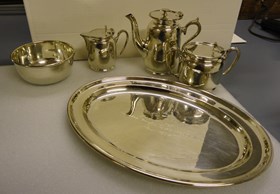Narrow Results By
- Date
- 1950
- Material
- metal; paper; glass; paint
- Catalogue Number
- 104.47.1007
- Description
- An old-fashioned metal alarm clock with a manual bell (4.0x8.0cm wide) on top. The face is off-white in colour and made from paper. The numbers on the face are in Roman numerals with gold-coloured ornate crosses in between each number. There is a round, intricate, gold-coloured design (7.0cm radi…
1 image
- Title
- Alarm Clock
- Date
- 1950
- Material
- metal; paper; glass; paint
- Dimensions
- 25.0 x 17.5 cm
- Description
- An old-fashioned metal alarm clock with a manual bell (4.0x8.0cm wide) on top. The face is off-white in colour and made from paper. The numbers on the face are in Roman numerals with gold-coloured ornate crosses in between each number. There is a round, intricate, gold-coloured design (7.0cm radius) in the centre of the face. There are two black clock hands, hour and minute, and two smaller mini faces (both measuring 2.0cm wide) above and below the centre of the face. The top mini face is an alarm, with numbers 1-12. The bottom mini face displays the seconds, in degrees of 10 with numbers. On top of the bell there is a gold-coloured ring, possibly used for carrying. There are two gold-coloured splayed legs to support the clock when upright. There is a golden banded detail around the circumference of the face and the body. On the back of the clock, there are two wind-up mechanisms, the viewer-left key is marked with “W.A.” and has an arrow pointing in a clockwise direction, the viewer-right key is marked with “W.T.” and has an arrow pointing in a counterclockwise direction. Situated between these wind-up mechanisms are two buttons that are arranged vertically. The top button controls the alarm and moves the hands in a clockwise direction. The bottom button is missing. Above the top button there is an “A”, and below the bottom button there is an “H”. There is also a slide-adjustment knob marked with an “F” on viewer-left and “S” on viewer-right (possibly used as a faster-slower feature for the alarm bell). There is also a button missing from underneath this slide-adjustment knob. Scratched into the top of the back of the clock is “Nick Morant Banff”. Written upside-down at the top viewer-right is “55.”
- Subject
- households
- timekeeping
- Nick Morant
- Credit
- Gift of Nicholas Morant, Banff, 2006
- Catalogue Number
- 104.47.1007
Images
This material is presented as originally created; it may contain outdated cultural descriptions and
potentially offensive content.
Read more.
- Date
- 1950 – 2006
- Material
- wood; metal; fibre; enamel; paper
- Catalogue Number
- 105.06.1040 a-b
- Description
- (a) One black and silver ballpoint pen measuring 15.5 cm in length. Located 4 cm from the top of the pen there is a hole, possibly used to attach the pen with a chain. (b) The holder consists of a varnished wood base, measuring 9.0 cm (height) x 9.0 (width) x 9.0 (length). The top of the object con…
1 image
- Title
- Ballpoint Pen
- Date
- 1950 – 2006
- Material
- wood; metal; fibre; enamel; paper
- Dimensions
- 19.7 x 9.0 x 9.0 cm
- Description
- (a) One black and silver ballpoint pen measuring 15.5 cm in length. Located 4 cm from the top of the pen there is a hole, possibly used to attach the pen with a chain. (b) The holder consists of a varnished wood base, measuring 9.0 cm (height) x 9.0 (width) x 9.0 (length). The top of the object contains a gold cylindrical holder mounted on a swivel ball that holds the pen. On the top of the holder, located in the middle, there is also a shield-shaped Canadian Pacific logo with a silver beaver on top holding a pen. The red shield contains the words “Canadian Pacific” in white lettered script with a white border around its circumference. Underneath the words “Canadian Pacific” there is a small white globe with the words “SPANS THE WORLD” written in silver. The front of the object is on a slant and contains a gold plaque with “NICK MORANT” engraved. The plaque measures 2.0 cm (height) x 7.7 (length). The bottom of the object has not been varnished. The holder has four green circular pads located in the four corners of the object and offer it greater traction. The pads measure 1 cm (diameter) each. There is also a “MADE IN U.S.A” sticker located in the top viewer-right corner. Located in the top middle (between the two felt pads) there is a screw that attaches the gold cylindrical holder that is mounted on the opposite side.
- Subject
- households
- office
- CPR
- Nick Morant
- Credit
- Gift of Nicholas Morant, Banff, 2006
- Catalogue Number
- 105.06.1040 a-b
Images
This material is presented as originally created; it may contain outdated cultural descriptions and
potentially offensive content.
Read more.
- Date
- 1800
- Catalogue Number
- 104.41.1125 a-b
- Description
- Two identical metal tripods with burgundy legs attached with white string. Three adjustable knobs are located at the top of the tripod allowing the metal bar inside to be adjusted maximizing the height. The folding and collapsible legs extend away from the vertical center in three sections to a len…
- Title
- Camera Tripod
- Date
- 1800
- Description
- Two identical metal tripods with burgundy legs attached with white string. Three adjustable knobs are located at the top of the tripod allowing the metal bar inside to be adjusted maximizing the height. The folding and collapsible legs extend away from the vertical center in three sections to a length of 54.0 cm. A fourth adjustable knob, located at the bottom of the metal bar and meeting the top of the legs, allows the user to extend the legs of the tripod to the desired height. Each of the four knobs has the maker’s mark inscribed and reads: “ACME- LITE-CHICAGO- ” around the circumference. The feet are at a 45 degree angle and have a rubber stopper on the bottom giving the portable three-legged frame greater stability to resist lateral forces. A tripod may have been used for motion and still photography to prevent movement or to help achieve precise framing of an image.
- Subject
- Nick Morant
- Credit
- Gift of Nicholas Morant, Banff, 2006
- Catalogue Number
- 104.41.1125 a-b
This material is presented as originally created; it may contain outdated cultural descriptions and
potentially offensive content.
Read more.
- Date
- 1840 – 1970
- Material
- silver; metal
- Catalogue Number
- 104.20.1150 a-e
- Description
- 5 piece heavy weight silver plated tea set consisting of a serving tray, tea pot, sugar bowl, creamer, and bowl. All pieces have the script-style “C.P.R.” monogram engraved. While all pieces were manufactured by Elkington belonging together as a set, they do contain different maker’s marks. George …
1 image
- Title
- Tea Set
- Date
- 1840 – 1970
- Material
- silver; metal
- Dimensions
- (a) 1.4; (b) 13.0; (c) 8.8; (d) 9.4; (e) 5.3 x (a) 22.8; (b) 7.0; (c) 7.2; (d) 5.3: (e) 12.3 x (a) 30.9; (b) 17.0; (c) 15.6; (d) 11.0; (e) 12.3 cm
- Description
- 5 piece heavy weight silver plated tea set consisting of a serving tray, tea pot, sugar bowl, creamer, and bowl. All pieces have the script-style “C.P.R.” monogram engraved. While all pieces were manufactured by Elkington belonging together as a set, they do contain different maker’s marks. George Richards Elkington was a manufacturer from Birmingham and is credited as the first person to patent the first commercial electroplating process.(a) A large oval-shaped serving tray engraved in early script with “C.P.R.” along the top edge. Also engraved in the same style of writing are the words “For “Willie” Morant from the staff of Canadian Pacific Corporate Archives 1 June 1981.” On rear the number “8960” has been stamped with a shield logo below that contains the letters “E & Co,” which is representative of the name Elkington. Below the shield logo are three separate hallmark; the first is “C” followed by “&” and “Co”. Below this in protruding letters is the name of the manufacturer “ELKINGTON” “PLATE” each blocked off in its own box. “A.T. WILEY Coy LIMITED MONTREAL” is inscribed. (b) Tea pot with an oval shape body and hinged lid. On the front of the teapot the “CPR” monogram has been engraved. On the teapots bottom there is the number “15167”with a shield logo below that contains the letters “E & Co.” Below the shield logo are three separate hallmarks; “C” followed by “&” and “Co”. Below this in protruding letters is the name of the manufacturer “ELKINGTON” “PLATE” each blocked off in its own box. There is also the letter “T” inside of a (c) The round, double handed sugar bowl has a hinged lid. On the front of the teapot the “CPR” monogram has been engraved. On the bottom of the sugar bowl the number “1” has been engraved inside of a circle. Beneath this are a series of numbers “15167.” A shield logo with the “&” is present above the letters “C,” “E & Co” and “Co.” “U” “46” also has been marked. “Elkington & Co” is engraved below. “A. T. WILEY Coy LIMITED” “MONTREAL” is engraved at the very bottom. (d) The round, cream pitcher has a hinged lid. The stamped marks on the bottom are as follows: "15167” followed by “&,” “E & Co.” (in a shield logo), “Co” “U.” Below this the manufacturer name reads: “Elkington & Co” is engraved below these marks. Following this is the location of manufacturing: “A. T. WILEY Coy LIMITED” “MONTREAL” is engraved at the very bottom. (e) The bowl has stamped marks on the bottom that are as follows: “1” (enclosed in a circle; "19842”; “&,” “C,” “E & Co.” (in a shield logo), “Co.,” and “R.” “Below this the manufacturer name reads: “Elkington & Co” is engraved below these marks. “A. T. WILEY Coy LIMITED” “MONTREAL” is engraved at the very bottom. Following this is the location of manufacturing: “A. T. WILEY Coy LIMITED” “MONTREAL” is engraved at the very bottom.
- Subject
- railway
- silverware
- decorative
- CPR
- Nick Morant
- Credit
- Gift of Nicholas Morant, Banff, 2006
- Catalogue Number
- 104.20.1150 a-e
Images
This material is presented as originally created; it may contain outdated cultural descriptions and
potentially offensive content.
Read more.






